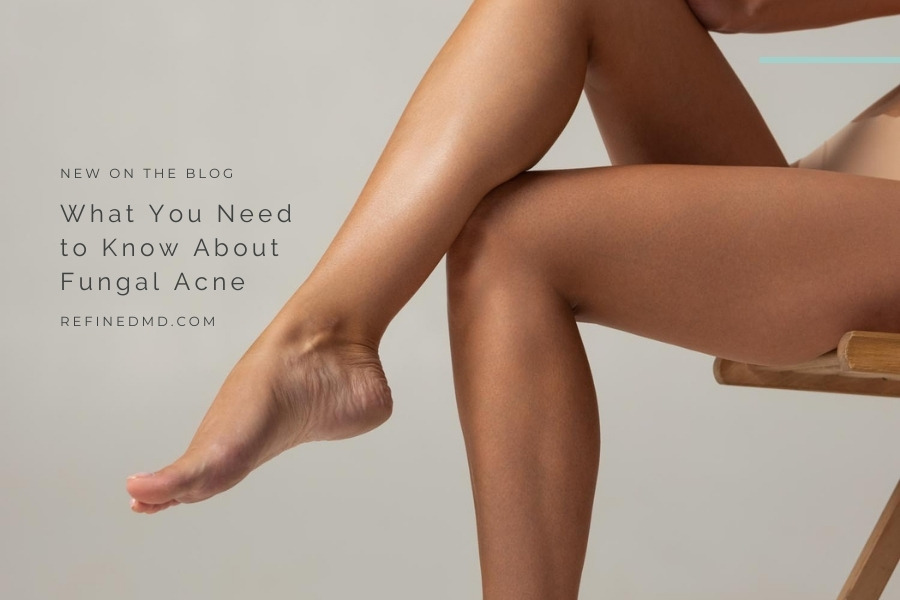
06 Feb What You Need to Know About Fungal Acne
There are many types of acne, and treatment depends on the type. Treatments area also split into two categories that overlap in many ways: medical/dermatological and cosmetic. RefinedMD is home to leading MDs as well as a suite of aesthetic dermatology experts because we understand the importance of marrying the medical with the cosmetic. For example, it’s important to get active acne under control, but signs of acne past—like scarring and hyperpigmentation—can also do a number on your self-esteem. It’s possible to treat both, sometimes simultaneously. However, this journey all begins with figuring out what kind of acne you’re dealing with.
It can often take a dermatology expert to properly differentiate acne types. Common types of acne like whiteheads, blackheads, and even cysts can sometimes be identified by laypeople. However, fungal acne can be much trickier. This is partially due to the fact that it isn’t actually, technically “acne.” It looks like it, but it’s not traditional acne (AKA folliculitis), which is a skin disease caused by bacteria. Instead, as the name suggests, it’s caused by a fungus or yeast. This means that common treatments for acne aren’t going to work on so-called fungal acne. You’re going to need an anti-fungal medication and probably some lifestyle changes if you want to stop and prevent fungal acne from occurring.
The Fakeness of Fungal Acne
Fungal acne isn’t even a medical term, though it’s one that’s been adopted (even by some dermatologists). The actual name for this condition is pityrosporum folliculitis. It’s not part of acne vulgaris, which includes blackheads, whiteheads cysts, papules, and pustules—these are all caused by bacteria and clogged pores. Fungal acne is caused by M. furfur, a yeast that gets rooted in the hair follicle. It’s actually much more comparable to dandruff than to acne, at least when it comes to cause and treatment. Plus, fungal acne is itchy—much more so than real acne. This can exacerbate the condition.
Many people misdiagnose fungal acne as a pustule or papule, two of the most severe forms of acne vulgaris. But it’s not as inflammatory as these kinds of acne and it isn’t cystic. Fungal acne presents as small bumps that are usually pink or skin colored. You might also be able to guess fungal acne based on its location. Real acne often presents in the T-zone, jawline, and neck and is often red in color. Fungal acne is most often found on the upper chest, temples and sides of the face, forehead, hairline, and on the back. Of course, both fungal acne and real acne can be found anywhere on the body, which is why it’s so important to see a skin care expert for all of your questions and needs.
Facts About Fungi
Nobody likes to hear that they have fungi on their face—but everybody does. It’s totally normal, but when the yeast goes into overdrive and delves into the hair follicle, that’s when fungal acne occurs. This is often prefaced with an event, such as taking oral steroids or antibiotics (one of the most common triggers). Antibiotics can be a literal lifesaver, but they do create and imbalance in bacteria. When all types of bacteria are depleted, this can tell yeast to overproduce. It’s the same reason some people are prone to vaginal yeast infections after taking a round of oral antibiotics.
Besides antibiotics, yeast imbalance can also be worsened when moisture gets trapped and fungi is allowed to breed. Sweating after a workout is one great example. Fungal acne thrives if you’re often in humid, moist, and warm environments. Additionally, some people are just more prone to getting fungal acne than others. This is particularly true for those with an autoimmune disease, but it can be common in just about anyone.
Treating Fungal Acne
Your skin care professional is the best expert to help you find the right anti-fungal acne treatment for you. You’ll also want to avoid activities that trap sweat on the skin, or make it a priority to shower immediately after activities that cause this environment. And if fungal acne has left pits, brown spots, or light scars from picking at this itchy condition, don’t worry. There are many treatment options, such as laser skin rejuvenation, chemical peels, and microneedling, to help with these lingering conditions. To find out more about getting a correct acne diagnosis and treating active and past acne signs, contact RefinedMD today by giving us a call or filling out the online contact form.
